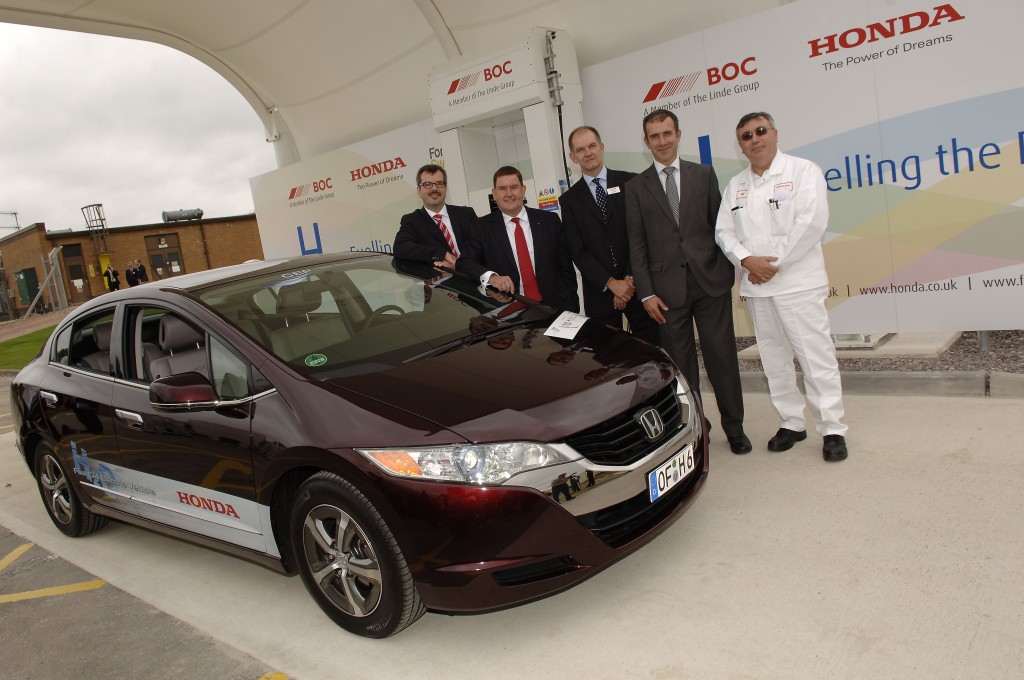 The UK’s first open access hydrogen vehicle refuelling station has been officially launched in Swindon – putting the town at the centre of innovation for what many believe will be the motoring technology of the future.
The UK’s first open access hydrogen vehicle refuelling station has been officially launched in Swindon – putting the town at the centre of innovation for what many believe will be the motoring technology of the future.
The station, at Honda’s South Marston car manufacturing site, will be open to anyone developing or using hydrogen-powered cars, vans or trucks.
In a ceremony attended by local dignitaries, business people and the media, Honda senior engineer Thomas Brachmann used the filling station to refuel a Honda FCS Clarity hydrogen-powered car.
The facility is designed to look like, and operate in the same way as, a conventional filling station. Refuelling takes less than five minutes.
Built and operated by industrial gases company BOC, the project is the result of a partnership between Honda, BOC and Swindon’s economic development company Forward Swindon.
BOC UK managing director Mike Huggon said: “This is not an experiment. It’s a piece of the jigsaw that leads to the sustainable society we are all craving.
“This station is state of the art. It can fill hydrogen vehicles from scooters to passenger cars and buses.”
Pointing out that it works with swipe-card technology, he joked: “We even have a Nectar points scheme.”
Experts say hydrogen has huge potential as a sustainable transport fuel, creating no emissions other than water vapour. Hydrogen-powered cars can travel around 270 miles on a full tank and are twice as efficient as a diesel car and three times more efficient than a petrol one.
Yet while all the major vehicle manufacturers are developing hydrogen-powered models, there are few refuelling facilities available to UK users meaning take-up is likely to remain low.
And in a catch-22, the major fuel companies will not invest in new facilities while there are very few hydrogen vehicles on the road. The automotive and low-carbon industries are urging the Government to do more to promote the use of hydrogen-fueled vehicles.
The Swindon station can fill vehicles at both 350 bar and 700 bar – the two standard filling pressures adopted by the world’s major vehicle manufacturers.
A range of hydrogen-powered vehicles including passenger cars, light commercial vehicles, an ambulance, a taxi and a London bus were on display at yesterday’s unveiling – with the bus used to ferry guests between the Honda site’s car park and the fuel station.
Richard Kemp-Harper, lead technologist for transport and energy at the Swindon-based Technology Strategy Board, said: “The change from conventional transport systems to sustainable, low-carbon alternatives is one that can only be made through businesses and government working in partnership to develop innovative solutions.
“This new refuelling station gives a real glimpse of the role hydrogen can play in practice. It is a great example of the kind of collaboration and innovation we need.”
Forward Swindon chief executive Ian Piper added: “I’m proud that we have been involved in such an exciting public-private partnership. Forward Swindon was the initiator of this project and brought together the funding: it’s a great example of how innovative projects can come to life in the UK, even in a recession. Swindon’s strategic location makes it the natural home for new transport technologies, and I’m confident this facility will encourage a growing interest and take up.”
He said Swindon could benefit from the economic advantages that came from developing innovative, low-carbon technology. As well as Honda, the town is also home to Johnson Matthey’s UK fuel cell research and manufacturing base which supplies some of its pioneering products to the automotive industry.
Pictured: Thomas Brachmann, Head of electrical power train R&D at Honda, Mike Huggon MD of BOC in the UK & Ireland, Ian Piper CEO Forward Swindon, Richard Kemp-Harper of the Technology Strategy Board, Mike Godfrey Chief Engineer at Honda UK in Swindon.














